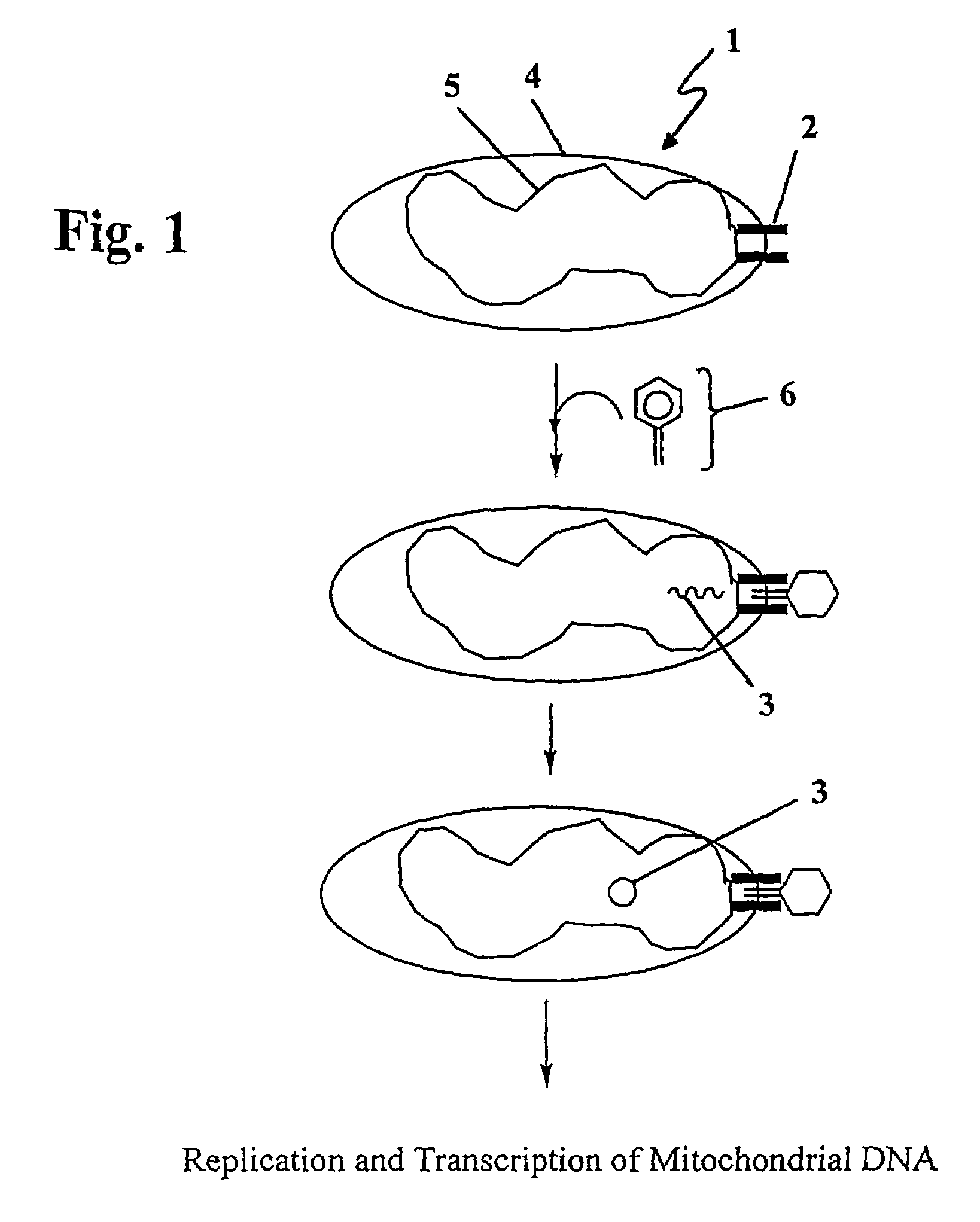Vector mediated organelle transfection
a vector-mediated organelle and transfection technology, applied in the field of vector-mediated organelle transfection, can solve the problems of not providing a direct manipulation mechanism of mtdna, not addressing, and many features of mammalian mitochondrial gene expression and respiratory chain biogenesis are not reproducible in yeast, so as to increase the biosynthesis restore or augment organelle function, and enhance the expression of specific nucleic acids
- Summary
- Abstract
- Description
- Claims
- Application Information
AI Technical Summary
Benefits of technology
Problems solved by technology
Method used
Image
Examples
example 1
Mitochondrial Localization of the Lambda Receptor in Mammalian Cells
[0090]Lambda receptor cDNA was PCR amplified from E. coli K-12. E. coli K-12 (ATCC) genomic DNA was PCR amplified using the Clontech HotStart System with the following primers: ATG ATG TTA CTC CTG CGC AAA C (SEQ ID NO: 1) and TTA CCA CCA GAT TTC CAT CAG GG (SEQ ID NO: 2). The cDNA was TA-cloned into pIND / Topo (Invitrogen). The resulting plasmid (pIND-LamB) was digested with BamHI and AgeI (NEB). pDsRed1-Mito (Clontech) was digested with BamHI and AgeI, and the 1.3 kb lambda receptor fragment was inserted downstream of the mitochondrial localization signal of subunit VIII of human cytochrome oxidase. DH5a cells were transformed and the resultant pMLS-LambdaR plasmid was isolated and transfected into Rho cells.
[0091]To test for mitochondrial localization of the lambda receptor, human SH-SY5Y neuroblastoma Rho0 cells devoid of mtDNA or ETC activity were transfected with the mitochondrially localized lambda receptor pla...
example 2
Transfection of Mitochondria and Expression of a Recombinant Gene Construct
[0092]The mitochondrial genome of control SH-SY5Y was PCR amplified around the region between the putative mitochondrial transcription terminator (MTTER) site and the tRNA for leucine. MtDNA was PCR amplified with EXPAND Long Template (Roche) using the following primers: ACA TAC CCA TGG CCA ACC TCC TAC TCC TCA (SEQ ID NO: 3) and CCT TTT CTT CTC CTT AAC TTG GAG ACT GAC (SEQ ID NO: 4). The following cycling parameters were used to generate the 16.6 kb product: 92° C. for 2 minutes, ten cycles of 92° C. for 30 sec, annealing at 58 ° C for 1 min, and 12 minutes of extension at 68 ° C. This was followed by 25 cycles of the previous ten cycles with a 20 sec step added to the extension time. The PCR product was ligated to NotI polylinkers and digested with NotI for insertion of EGFP (the mtDNA / EGFP / BamHI construct). Alternatively, the PCR product was ligated to BamHI polylinkers and digested with BamHI for ligation ...
example 3
Rescue of a Mitochondrial Defect
[0105]The lambda bacteriophage-based mtDNA transfection strategy can also be used to rescue cell lines carrying mtDNA's from patients with mitochondrial diseases or mtDNA's mutated in vitro. For example, Leber's Hereditary Optic Neuropathy (LHON) is a disorder caused by mutations in mtDNA. The mutation in the NADH dehydrogenase subunit 4 gene is a G→ A transition at nt11778. This removes a restriction site for SfaN1. Therefore the presence of this mitochondrial defect can be detected by restricting the cells DNA with SfaN1 and observing the resulting fragments by gel electrophoresis. LHON cybrid cell lines were generated from a patient with Leber's Hereditary Optic Neuropathy (LHON), and these cells contained only the mutant mtDNA. Using the transfection strategy of the present invention, wild-type SH-SY5Y mtDNA was introduced into the LHON cybrids. These LHON-mtDNA transfectants demonstrated delivery of wild-type mtDNA.
[0106]Detection of the mutant a...
PUM
| Property | Measurement | Unit |
|---|---|---|
| nucleic acid | aaaaa | aaaaa |
| energy | aaaaa | aaaaa |
| length of time | aaaaa | aaaaa |
Abstract
Description
Claims
Application Information
 Login to View More
Login to View More - R&D
- Intellectual Property
- Life Sciences
- Materials
- Tech Scout
- Unparalleled Data Quality
- Higher Quality Content
- 60% Fewer Hallucinations
Browse by: Latest US Patents, China's latest patents, Technical Efficacy Thesaurus, Application Domain, Technology Topic, Popular Technical Reports.
© 2025 PatSnap. All rights reserved.Legal|Privacy policy|Modern Slavery Act Transparency Statement|Sitemap|About US| Contact US: help@patsnap.com



